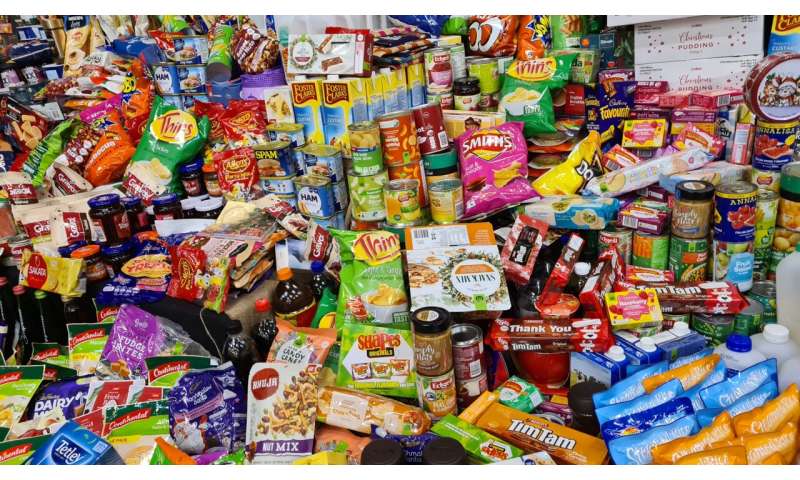Too much junk food changes how we get our protein, and it could lead to weight gain

New research presented at this year's International Congress on Obesity in Melbourne (the biennial congress of the World Obesity Federation) shows how increasing consumption of ultra-processed foods (UPFs) is associated with both dilution of protein consumption and increasing BMI and overweight/obesity. The study is by Dr. Amanda Grech, University of Sydney, Australia, and colleagues.
The protein leverage hypothesis states that dietary protein dilution (meaning reduction of the proportion of energy contributed by protein in the diet) has contributed to the obesity epidemic. At the same time, in the past 20 years UPF consumption has risen from contributing 52% to 57% of total energy intake in the U.S. in adults.
Various methods can used to categorize the extent of processing in food—for example the NOVA system uses four levels to assess industrial processing, where level 4 is the highest level. Other methods include referring to "discretionary foods" (DF), which identify nutritionally undesirable foods such as those high in added sugar, saturated fats, added salt or alcohol (and thus are typically highly processed).
Dividing the extent of consumption of UPF into five groups from the bottom 20% to the top 20% (quintiles) has been shown to be associated with increasing energy intakes and the dilution of energy provided by protein from 18.2% to 13.3%, even though absolute protein intake remains consistent across the five groups. This new study compared these different methods of assessing 'unhealthy' of foods with how they dilute protein energy intake, and their subsequent association with overweight / obesity.
The team used an approach called nutritional geometry, which was invented by team members Professors David Raubenheimer and Stephen Simpson, to detect complex nutritional associations in diets. It untangles the multi-dimensionality of diet as when one nutrient changes, other nutrients change as a consequence. The approach allows multiple components to be observed at the same time and to observe how nutrients interact.
After assessing both the UPF and DF systems, the researchers found that UPF contributed 57.2% of daily energy intake and DF contributed 44.5% of energy intake. Increasing UPF consumption from the bottom to the top 20% led to protein dilution from 17.5% to 12.5%, and a rise in non-protein energy intake by 1860 kJ (445 calories) at the highest 20% of UPF intake compared to the lowest 20%
There was also a decrease in the proportion of energy from protein by 18.7% and 12.4% from the bottom 20% to the top 20% of DF consumption, with energy intake rising by 2308 kJ (552 calories) to a maximum on the highest quintile of DF intake compared to the lowest quintile.
The researchers also analyzed mean body mass index (BMI) related to these changes, excluding low energy reporters (participants who had very low energy intakes and were excluded to improve the estimates). BMI increased as consumption of processed/discretionary foods increased. Mean adult BMI increased across DF quintiles from 28.4 (bottom) to 29.9 (top), and across UPF quintiles from 27.8 (bottom) to 30.5 (top).
The authors say: "Foods that we would describe as unhealthy, whether termed discretionary foods or ultra-processed foods, comprise a substantial proportion of energy intake and increased intake results in protein dilution in the diet and higher energy intakes. Increasing discretionary food consumption was associated with a higher absolute energy intake compared with increasing UPF consumption, while increasing ultra-processed food consumption was associated with a larger increase BMI compared with increased discretionary food consumption. However both increased ultra processed food consumption and increased discretionary food consumption are associated with overweight/obesity and interventions to improve dietary patterns are critical."
A reduced proportion of energy from protein increases total energy intake because several studies, including randomized controlled trials have now found that people consume a fixed target of protein each day. Dr. Grech says: "In this study we found that regardless of how much discretionary food or ultra-processed foods was consumed, participants consumed 1400 kJ (334 calories) of protein. The consequence of trying to achieve our protein target each day is that we overconsume carbohydrate and fats when the foods we consume are 'protein diluted' in order to achieve this, elevating total energy intake."
Dr. Grech says while it's clear what we must do—avoid over-consumption of UPFs/DFs -it is easier said than done. She explains: "We should avoid foods with cheap fats, sugars and refined starches with lots of colorings, flavorings and artificial preservatives—these are ultra-processed foods and include foods such as ready meals, commercial breads, processed meats, fast foods, confectionary and snack foods. Instead we need to replace them with minimally processed foods including fruits, vegetables, wholegrains and lean sources of protein such as fish, legumes, eggs, whole nuts or poultry and small amounts of dairy products. Discretionary foods are those high in saturated fat such as cream and butter or other solid fats at room temperature, added sugar, salt and alcohol and should be kept to a minimum, selecting fresh foods instead."
Provided by International Congress on Obesity